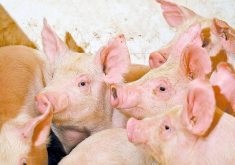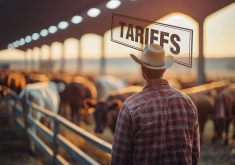As the fall run begins, many analysts are still talking about the big price break in calf prices. As I watch the world scene, it becomes apparent that the effect of the drought covering most of Russia will be a bigger factor in calf prices than we had anticipated. At the time of writing, wheat futures were continuing strong and Russia, a large exporter of wheat, has banned wheat exports.
The strength in wheat has carried over into other grains, including corn, on which the North American feed market is priced. As corn is dragged along on the shirt-tails of wheat, it will be just a matter of time before barley prices also feel the tug. The result will keep the lid on the feeder cattle prices. Any pressure on feeder cattle pricing will certainly be met with frustration, and folks will consider retaining ownership.
Read Also

Horns aren’t unlocking anytime soon on livestock transport standards
Standards good enough meet the definition of “humane” animal transportation still vary widely between what what industry wants, what animal rights advocates want and, between the two, what federal regulators decide is good enough.
Evaluation of retained ownership is more than numbers.
First, one has to evaluate their level of risk and their risk tolerance and then carefully consider the value of the inventory being retained. Let’s look at an example.
Five farmers are walking in a field and they come upon a canoe at the side of a lake. Four of the farmers stare at the canoe. The first farmer is risk nave and jumps into the canoe without a paddle and floats away, destination unknown.
The second farmer is risk averse and carries on about how he has never been in canoe and how he does not like the water and is afraid of getting cold. He is in only after being coaxed but not convinced.
The third farmer is risk tolerant and studies the canoe closely, finds a life-jacket, glances out into the horizon and then carefully paddles to a destination of the other side. Farmer No. 4 is a risk junkie. He runs back to the truck, finds a 350-hp outboard, throws the paddles in the bush and zips across the lake. In doing so he does one of two things, he sinks, or he discovers something in the process that he goes home to patent and becomes a millionaire.
The final farmer is sophisticated in his approach to risk and has not even looked at the boat. He looks at the water and decides to walk just a little farther where he discovers the water is not really a lake, but a quiet pool upstream from a waterfall. Only he has seen that waterfall. Does he need to get downstream or even to the other side? Where does the water go?
When considering retained ownership of calves and yearlings, it is also important to understand that one cannot own their way out of a production efficiency loss. If it is costing you $130 cwt to produce a calf, then there is really no market that will recover that loss. On the other hand, if it is costing you $90 cwt to produce a calf then there is enough opportunity in the market to make that happen.
Just as the feedlot is cost plus, so must be the backgrounding lot. If you plan to background at home, your yardage costs are still those of any other feedyard, and today that is $.70 per head day. The yardage cost on cattle that gain 1.3 lbs. per head day is $53 cwt per pound of gain while the yardage cost on calves that gain 2.0 lbs. per head day is $35 cwt per pound of gain. That $45 per head margin can make or break the year.
The fundamentals have to support the project. Simply, the margin must be discovered and hopefully locked in before the cattle are placed on feed. Cattle fed without a specific end target are easy prey to be fed at a loss, especially in an environment of rising feeding costs and an appreciating dollar.
Like the sophisticated farmer, you need to walk down the shore of the lake to see what is going in the future. In doing so, you may discover that you do not want to get into the canoe at all!















